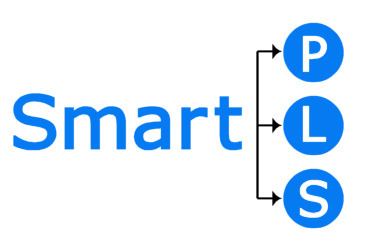Developer(s) SmartPLS GmbH Operating system | Initial release 2005 (2005) | |
 | ||
Original author(s) Stable release SmarPLS 3.2.6 / November 13, 2016; 4 months ago (2016-11-13) | ||
SmartPLS is a software with graphical user interface for variance-based structural equation modeling (SEM) using the partial least squares (PLS) method. The software can be used in empirical research to analyse collected data (e.g. from surveys) and test hypothesized relationships. Since it is programmed in Java, it can be executed and run on Windows and macOS operating systems.
Contents
Downloads
Data
SmartPLS uses raw data. The data import uses the text (.txt) and comma separated values (.csv) file format. The columns of the data file represent the variables; the rows represent observations and responses. Only the first row of the data matrix, which becomes the header in SmartPLS, can contain text. Otherwise, only numbers are allowed. Empty cells (e.g., if a missing value occurs) are not allowed. A number that is not used otherwise in the dataset (e.g., -999,999) must be used to fill empty cells. After data import, the user can indicate that this number represents a missing value. SmartPLS automatically identifies the data and number format (e.g., Europe or the USA). If a problem occurs, the user can later determine file format specifications and the number format in the software. In addition to the variables used as indicators for PLS path modeling, the data matrix can contain a weighting vector of the observations and responses (e.g., for carrying out weighted PLS path modeling analyses) and grouping variables (e.g., for conducting a PLS multigroup analysis, PLS-MGA).
Graphical User Interface
The graphical interface allows users to create a PLS path model. Circles represent latent variables and rectangular their indicators. The indicators stem from the variables of the imported data set. Drag and drop allows assigning indicators to a latent variable and, thereby, to establish the measurement model. In the structural model, an arrow drawing option allows the user to connect the latent variables with each other.
Algorithms
The primary basic partial least squares algorithm (Wold 1982, Lohmöller 1989) is the primary algorithm used in SmartPLS. The following list provides an overview of implemented algorithms and analytical options:
Blindfolding is only applied to constructs with a reflective measurement model specification.
Documentation
In-built Documentation. For every algorithm, an in-built documentation gives a short explanation. It also provides information regarding the parameter setting of the algorithms. References to key articles allow the user to access more detailed information about the specific algorithms and analysis options.
Results Report. For every analysis, SmartPLS offers a results report, which contains information about the model and data used for the analysis, key results, quality criteria (if relevant for a certain algorithm) and graphical results presentation (if applicable). The default offers a results representation within the SmartPLS software. In addition, SmartPLS allows exporting the results as a Microsoft Excel file, an HTML file, and in a file format that can be used by the statistical software R.
